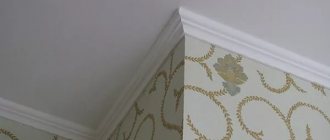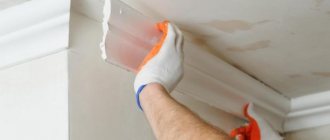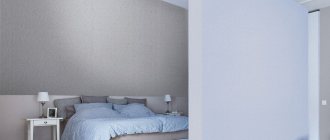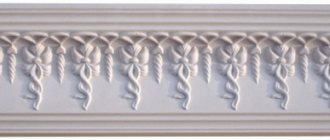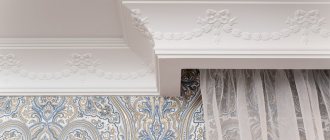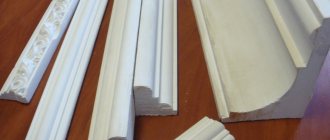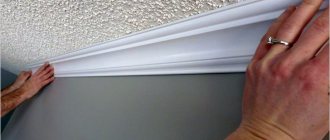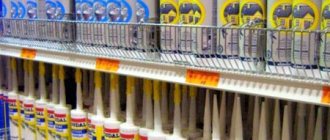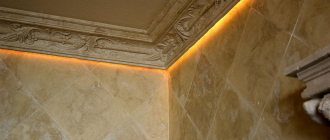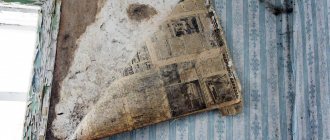Ceiling plinth for wallpaper, how to glue: selection of material
Upper skirting boards are used to hide all visible boundaries of wallpaper and whitewashed ceiling trim. In addition to this necessary function, they add decorative value to the ceiling, because fillets decorate the interior and give the overall look completeness.
There are several types of fillets for organizing work with the upper part of the room. Their main difference lies in the materials and manufacturing method. It is with these points that their physical properties are associated.
Ceiling plinth adds completeness to the overall look
In order to make baguettes, the following 4 materials are used:
- Wood. Wooden skirting boards can look great in any interior. It doesn’t matter at all what style, folk or classical. In order to make wood fillets, mahogany, oak, walnut or larch are mainly used.
- Stone. Sometimes in special retail outlets you can find ceiling skirting boards made of artificial stone. They are able to fit perfectly into a classic interior, and combine well with modern types of decoration. The cost of such material is high, due to the fact that it is very difficult to extract the material.
- Gypsum fillets. Thanks to gypsum, you can create skirting boards of various types and shapes. They are much lighter than the previous material, and also much cheaper. However, before purchasing this material, you need to be sure that the surface of your walls, polystyrene foam, foamed polyvinyl chloride and other types of plastic is ideally even.
- Plastic panels. At the moment, modern manufacturers are increasingly giving preference to the production of plastic products. Ceiling plinths are no exception. In special construction stores you can purchase polyethylene panels.
If we talk about soft and flexible materials, then these include plastic and some wooden baguettes. Already, based on this, we can answer that it sticks first. If the product is flexible and belongs to the budget category, then you can try installing ceiling skirting boards on wallpaper, but you should take into account that there are no perfectly smooth walls, this does not apply to baguettes, therefore, you cannot avoid working with putty. If the fillets are soft and can adapt to the curvature of the walls, then putty may not be needed.
Is it possible to glue ceiling plinth to wallpaper?
If we talk about this method, then at first glance it may seem quite simple. However, only experienced specialists use it, because they immediately treat all cracks and irregularities with putty, and the wallpaper undergoes a leveling process. All you need is a little practice and you will be able to do the job just as well.
Skirting boards for the ceiling can create the impression of a complete absence of unevenness on the walls, but in order to achieve this, you need to carry out proper installation.
Based on this, you can understand what exactly is being done first, installing the baseboard or gluing the wallpaper.
You can glue the ceiling plinth with your own hands, without the help of specialists
In any case, prepare the following materials and tools for work:
- Polymer glue;
- Assembly adhesive;
- Putty;
- PVA glue;
- Construction knife;
- Hacksaw;
- Miter box;
- Putty knife;
- Ruler;
- Pencil;
- Sandpaper;
- Colorless sealant;
- Paint (if necessary).
Despite the fact that at the moment you can purchase any material for installation, it is better to use the glue recommended by the manufacturer.
Choosing adhesive for foam baseboards
So, we found out what to glue first - the ceiling plinth or wallpaper. The order of the procedure in this case will depend on the material used for the finishing and molding. But of course, in order for the walls in the room to look neat in the future, skirting boards of any type must also be installed correctly.
As already mentioned, property owners usually install only foam or polyurethane flexible lightweight baguettes on their walls with their own hands. The first type of skirting boards is attached to the wall using a very simple method. To install baguettes of this type, you usually use the same glue that was used when installing wallpaper. Liquid nails can also be used to attach such decorative elements.
How to glue ceiling plinth to wallpaper
After you decide exactly how you will attach the baguettes to the ceiling, the question remains open, what kind of material can be used to glue the baguette to the wallpaper.
For this purpose, the following are most often used:
- Assembly adhesive;
- Polymer glue;
- Putty, which contains PVA.
There is no significant difference in the use of the adhesive solution, the main thing is that its drying speed is maximum.
You can glue the ceiling plinth to the wallpaper with glue or putty
You can proceed to the process of gluing the skirting boards only when all the preparatory work has been completed. Namely, removing dirt and dust, as well as pruning.
In order to glue the prepared plinths, you need to turn them over on the back side and apply a small amount of glue, it is desirable that the strip is even and does not go beyond the contours. After the solution has been applied, the fillet is set aside to allow the glue to settle.
If you see that the glue has come out beyond the edge, remove it with a dry soft cloth. After this, the first baguette is leaned against the desired place on the ceiling and pressed without strong pressure. You should not remove your hands for about a minute so that the baguette sticks well to the base.
Basic rules: how to trim wallpaper to fit a ceiling plinth
In order to get a good and high-quality result, all procedures must be performed competently and with the right approach. There are no small details in this installation, and the owner who neglects trimming wallpaper at the edges of the walls will become irresponsible.
In fact, not every craftsman knows how to properly cut or paste wallpaper around baseboards.
In order for the result to please you, all procedures must be carried out very competently.
In fact, every homeowner has baseboards under the ceiling. You need to know that each layer of coating on the wall must be glued in such a way that the edges protrude onto the fillets. After this, take a small spatula and run it along the lower edges of the contact between the panels and wallpaper. The result should be a fold.
After performing these steps, press the folded area with a spatula and carefully remove the protruding edges of the paper with a sharp construction knife. The trimming process is complete. If you notice that glue has released, it can be removed with a damp cloth or sponge. As a result, you will get a neatly decorated room with smooth edges.
Types of ceiling plinths
In fact, the floor plinth differs from the ceiling plinth only in the material from which it is made. Strong, mechanically damage-resistant planks are installed in the floor area, and any kind can be installed under the ceiling, because there they are practically inaccessible.
| Photo | Recommendations |
| Paper skirting boards. This edging is also called a frieze or border. At a stretch, decorative paper strips can be classified as skirting boards, but formally they are considered such. In terms of order, the paper border is always glued on top of the wallpaper. | |
| PVC plinth. Plastic baguettes are mounted on the ceiling only if the ceiling is sheathed with the same plastic. As you can see in the photo, they even have a groove for such panels. These baguettes are attached either to the sheathing or to the ceiling. As for wallpaper on the walls, before filling the wallpaper, the plastic is simply folded back and the wallpaper is glued. Formally, here the plinth is mounted on the wallpaper, although the fillet is attached to the ceiling. | |
| Polyurethane moldings. Flexible polyurethane baguettes are now considered the most popular. The material is light, durable and at the same time elastic. Such baguettes cannot be distinguished from the same plaster, and they can be mounted both on and under wallpaper. We'll talk about the intricacies of installation a little later. | |
| Plaster stucco. Before the advent of polyurethane and foam, gypsum was extremely popular. The baguettes are beautiful, but quite fragile and heavy, which makes them more difficult to install. In no case should gypsum products be mounted on top of wallpaper. | |
| Foam edging. If installed correctly, foam moldings cannot be distinguished from plaster or polyurethane, but their price is more than affordable, plus anyone can glue them to the ceiling. People often glue foam fillets to wallpaper so that when they change the wallpaper, they can also replace the fillets, because foam plastic is cheaper than wallpaper. | |
| Wooden fillet. Wooden edging is now considered elite. Such skirting boards are often attached to the base with dowels and nails; the problem is that they require perfectly smooth walls and ceilings. If, for example, the distortions under a plaster border can be covered with putty, then this trick will not work here. | |
| Stone border. Marble, granite and other stone products cost incredible amounts of money, plus they are very problematic to install. As for wallpaper, firstly, not every canvas will fit under a stone frieze, and secondly, heavy stone is never mounted on top of wallpaper. |
Finishing at the final stage
No matter how the apartment owner decides to glue the ceiling plinth - before or after the wallpaper - at the final stage he will most likely have to paint this decorative element.
After installation, craftsmen usually coat wooden baguettes with special oils, wax or varnish. Stone skirting boards are beautiful in themselves, and after installation they are not further trimmed. At the final stage, foam and polyurethane baguettes are in most cases painted using water-dispersed agents.
Subtleties of arranging different options
Although there are many types of ceiling moldings, they can all be divided into 2 areas:
- Flexible and lightweight - this includes polyurethane, foam and polyvinyl chloride. This direction can be mounted both on top of the wallpaper and end-to-end with the canvas;
- Hard and heavy - here we have plaster, wood and stone. All of them are mounted end-to-end only. The fact is that not a single wallpaper, even the densest one, can withstand such weight, plus it is often necessary to level the walls under hard baguettes.
When and how the fillet is attached to the wallpaper
Experienced craftsmen are strongly against this approach, because this is, in fact, a one-time option. If you start changing the wallpaper, you will have to remove the frieze, which means double work. But people are afraid that without experience they will not be able to beautifully arrange the joint between the baguette and the canvas and glue the baguette on top.
Only light baguettes can be glued to wallpaper.
But let's return to practice: let's start with the fact that the baguette can only be glued to non-woven wallpaper or vinyl wallpaper; the paper can only withstand a thin foam frieze, nothing more. I'm glad that the instructions are the same in all cases:
- The frieze is glued on top of the wallpaper after the walls are completely dry, which is about 2-3 days from the end of gluing;
- 1-2 strips of thick universal glue, such as “Moment-montage”, are applied to the back side of the baguette, after which the baguette is applied to the junction of the ceiling and the walls and held for about 30 seconds;
- If glue oozes out from under the baguette, it is immediately wiped off with a soft rag.
It is not recommended to glue the frieze onto canvases with large, protruding relief, as there will be small gaps under the plank, and this will ruin the look.
Foam baguette is considered the most affordable and simple option.
Another common question is how to remove the ceiling plinth without damaging the wallpaper? I’ll say right away - this is unrealistic. If the baguette is glued, then when you try to remove it, it will tear the top layer of the canvas. And if the strip is screwed on with self-tapping screws, which is also possible, then the screws have already gone through the canvas and it is damaged.
How to properly install a flexible polyurethane baguette
As we found out, the answer to the question of whether to glue such a ceiling plinth before or after the wallpaper depends on the material used to make the latter. Polyurethane baguettes are installed using approximately the same technology as foam ones. The only thing is that in this case you should take a closer look at the choice of glue. Solvent-based compounds are not suitable for installing polyurethane skirting boards. When installing such a baguette, glue should also be applied to the joints between the elements.
Since a polyurethane baseboard weighs more than a foam baseboard, it will take longer to hold it with your hands before gluing it to the wall or thick wallpaper. In those places where such a baguette does not stick to the surface due to the unevenness of the wall, it can be temporarily secured with nails. Also, experienced craftsmen advise nailing down the upper corners of the planks at the joints when installing them. After the baguette is securely glued to the wall surface, the nails will need to be pulled out of it.
Excess glue protruding from under the planks when installing polyurethane baseboards is removed with a wet sponge. In some cases, after installing a flexible baguette in place, gaps may remain between its elements. It will not be difficult to seal such holes, for example, with silicone sealant or acrylic putty.
